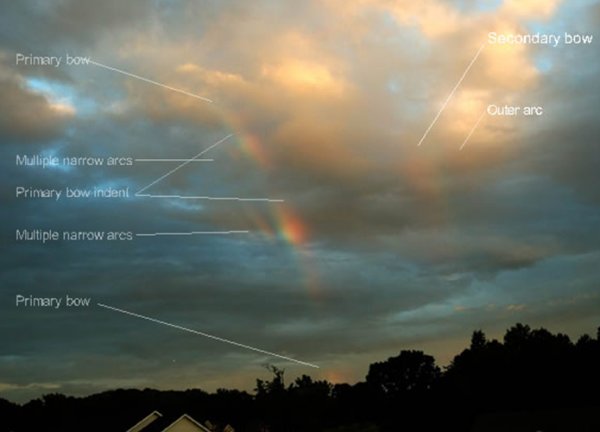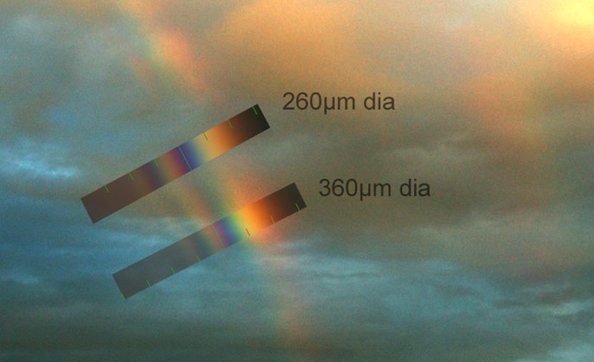| This letter from atmospheric optics expert Les Cowley to photographer Charles Tilley explains the formation of the strange "Statesville Rainbows" of July 29, 2006. STATESVILLE RAINBOWS 2020 local DST, July29, 2006
What
was ordinary about them? 2) Outside the primary was
a bright fragment of secondary
bow arising from two
reflections inside the drops. That the primary and secondary were fragmented indicated that there were a number of localised showers of rain. What was not ordinary? 2) Indents in the primary at the levels where the sets of multiple arcs were most widely separated. These are only evident on enhanced full size images. 3) A faint coloured arc outside
the main secondary bow. Multiple rainbows are produced by sunlight reflecting off sheets of water. However, the nearest water was 28 km to the West and 56 km to the SouthEast. In any event the multiple bows were too narrow and wrongly placed for reflection bows. Violent showers sometimes
produce the enigmatic "twinned
bows." The faint arc (3) outside the secondary gives the clue to what was actually happening. It is a supernumerary bow to the main secondary: http://www.sundog.clara.co.uk/rainbows/supsecs.htm Supernumeraries are produced by small raindrops. As drops get smaller, the wavelength of light gets more and more significant. Light is diffracted and forms predominantly green and purple fringes inside the primary: http://www.sundog.clara.co.uk/rainbows/supers.htm Supernumeraries are not uncommon but a bright supernumerary to the secondary is very rare. That it is present and so bright tells us that in that region the raindrops (1) have a narrow range of
sizes and The existence of small raindrops with a narrow range of sizes also provides a neat explanation for the multiple arcs inside the primary! They are also superneumeraries but this time to the primary bow. They are not their usual colours because they are produced by sunset reddened rays. Why the fan like
spacing? What we have here are localised showers with changing drop size across the shower. Showers usually have the smallest drops at their edges. In this event – and for reasons I do not know – the shower dropsize varied smoothly from small drops to larger ones across a small part of the sky and so produced the fan-like structure. Can we say what size the drops were?
Yes. Above is an enhanced version of the original picture. I determined its angular scale from the red, orange, and green separations of the main primary and secondary bows. These can be calculated exactly. Once that was done I could superimpose on it simulations of rainbows calculated by Airy scattering theory. The two simulations are for drops of the size indicated but with a distribution of drop sizes around the mean value characterised by a standard deviation of 15%. The simulations match the spacings of the upper and lower parts of the ‘fan’ reasonably. The upper simulation tells us more. As the drop size decreases the main primary bow shrinks slightly. This is the reason for the two indents in the Statesville bow. Why were so many
supernumeraries visible? Why are the supernumeraries
not visible elsewhere?
That evening over Statesville there were several localised showers that produced fragments of a primary and secondary rainbow. Some showers had raindrops smaller than 0.4mm with a very narrow range of sizes. These produced bright primary supernumeraries and a very rare secondary supernumerary. The drop size varied smoothly across two areas of sky and so produced supernumeraries of smoothly changing spacing that gave them a unique fan-like structure. You will not see something like that again for a very long time!
|

